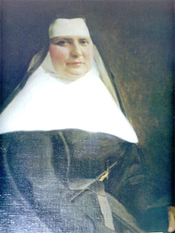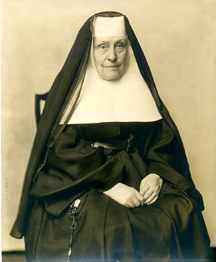“Cultivate the vine that has been entrusted to you.”- Angela Merici
Our roots go back to 1535 when, in Brescia, Italy, St. Angela Merici began a new kind of religious life for women considered radical in her time. Angela’s original vision for her followers was a company of women who chose not to live the traditional form of religious life — enclosed in a convent and separated from the world. Rather, they lived and worked among the people, combining contemplative prayer with active service to those in need. They transformed society by nurturing the roots of families and the intellectual and spiritual lives of women. From these simple beginnings, St. Angela’s company, placed under the special patronage of St. Ursula, spread throughout Europe and to the “New World” in 1639.

Mother Fidelis Coleman
It was into harsh frontier conditions that Mere Marie of the Incarnation and several companions brought the Ursulines to North America from France. At the time, Quebec was populated by Algonquin Indians and French settlers. As the first women missionaries, the Ursulines came to bring the Gospel to native girls and the daughters of settlers. Other North American foundations followed as the Ursulines carried forth their mission of education. In 1845, Mother Julia Chatfield and her 10 companions arrived from France, beginning the history of the Ursulines in Ohio. Under Mother Julia’s leadership, the Ursulines brought education to rural Brown County, attracting students from far and wide.
The tradition of outreach and service of the Ursulines of Cincinnati began with 20 Sisters who traveled to the city from Brown County in 1910 at the request of then Archbishop Henry Moeller. Under the leadership of Mother Fidelis Coleman and Mother Baptista Freaner, the Sisters were charged with educating the children of a new wave of immigrants to the area in parish schools.

Mother Baptista Freaner
They chose to establish their community in Walnut Hills, a diverse neighborhood perfect for carrying out their mission of service and being present to their neighbors. Two Victorian mansions were purchased on McMillan Street to house the convent and St. Ursula Academy, which opened its doors on Sept. 18, 1911, with 63 students in grades one through twelve.
Holy Name School in Mt. Auburn soon became the first parish school staffed by the Sisters, followed by St. Monica in Clifton Heights. Over the years, the Ursulines of Cincinnati also shaped young hearts and minds at numerous other schools, including Nativity, All Saints, Our Lady of Visitation, St. Francis de Sales and St. Henry School in Dayton, OH., along with teaching religious education courses during the summer months to children in rural areas of the archdiocese.
As the academy grew and requests for the Sisters’ presence in parish schools increased, the need for new members became evident. Mother Baptista, accompanied by Mother Bernard Morgan, made a recruitment trip to Ireland in 1919, returning with seven candidates. More Irish Sisters soon entered the community as well, bringing humor and wit, along with great dedication to the church and local community.
By 1935, the community numbered 55 members and there were 200 students in attendance at the academy. With the start of World War II, the Ursulines did their part by knitting for the soldiers. In addition, the convent and academy were designated as a bomb shelter and emergency medical facility, and the Sisters were trained in civil defense skills. Aided by the students, they fashioned blankets from old sheets and tablecloths and were ready if pressed into service.
The peace and stability of the 50’s was followed by changing times in the 60’s and 70’s, and the Cincinnati Ursulines responded with characteristic faith and flexibility. In the early 60’s, they welcomed two groups of Cuban Sisters who had fled Fidel Castro’s regime. While at St. Ursula, the nuns, members of the Apostate of the Sacred Heart and Sisters of Charity, studied American teaching methods under the Ursulines in preparation to to instruct refugees in the Archdiocese of Miami. The Ursulines also warmly received a group of Cuban refugee children, giving them scholarships to attend St. Ursula.
The openness in the Catholic Church after Vatican II led to new ministry opportunities for the Sisters, including social work, pastoral ministry and counseling. They found creative solutions to the racial, economic and justice issues of the 60’s and 70’s, reaching out to the residents of low-income neighborhoods, teaching in urban schools and recruiting minority students to attend St. Ursula. The community founded the Walnut Hills Outreach Center, which offered GED preparation, and the Community Outreach Program, focused on youth education and employment training.
By the 1980s, the Sisters began to transition their parish school ministry to lay teachers and administrators. While still firmly committed to education, the Ursulines’ ministries have since expanded to include campus ministry, Catholic communications, community health and outreach, parish religious education and school counseling. The Sisters are also active in other ministries in Cincinnati and beyond, such as nursing home and hospital visits, Peace Camp, RCIA instruction, Citizens on Patrol and chaperoning mission trips for academy students.
In keeping with St. Angela Merici’s ministry to empower women, the Ursulines, in collaboration with their lay staff members and friends, have established the Virginia Noll Starfish Project. Geared toward helping women in crisis, Starfish helps make a difference in the lives of those who may not qualify for traditional social service assistance. Starfish can change a crisis into an opportunity by providing financial grants and contact with a network of volunteers who have skills and professional talents to share. Starfish also works with other social services agencies to form a coalition that collaborates on services, enhances visibility in the wider community and shares in funding efforts.
Having celebrated our centennial anniversary in 2010, we build upon our roots and look to the future with faith and optimism.
